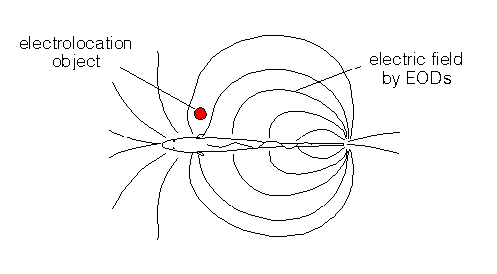Behavioral Neuroscience, lecture on electric fish
Jamming
VI. Efferent ouput to produce EOD
A. Pacemaker nucleus (Pn) in medulla
1. modulatory inputs lead to distinct behavioral patterns
a. alter neuronal firing rate
i. Glu input from diencephalon (PPn) to pacemaker cells
(1) AMPA/NMDA
ii. Glu input from mesencephalon (SPPn)to relay cells
(1) NMDA
b. pacemaker + relay fire 1:1 with EO electrocytes
2. pacemaker cells
a. connect with each other and relay cells
i. mixed synapses (chemical and electrical)
b. synchronous firing
3. relay cells
a. project to spinal motor neurons
b. Glutamate output
B. Motor neurons in spinal cord
1. specialized electromotor neurons
a. innervate electrocytes of electric organ
i. innervate just one side
ii. Eigenmannia and all other electric fish
(1) except Apteronotus
b. comprise electric organ itself (Apteronotus)
i. branched nerve endings
2. stimulated to fire by AMPA/NMDA receptors
a. Glu from Pn relay cells
3. ACh = acetylcholine output
a. similar to neuromuscular junction
C. Electric Organ
1. Size and shape depend on environment and function
a. Weakly electric fish
i. native to highly conductive water
(1) short, broad electric organs
ii. less conductive water
(1) long, thin organs
b. Extends bilaterally from tip of tail anteriorly
2. Electrocytes
a. Modified striatal muscle fibers
i. maintained/driven by ion channels
(similar to Na+/K+ ATPase)
b. Flat disc-like multinucleate cells
i. stacked similar to a battery
(1) parallel rows along length of organ
(2) ñ stacks of electrocytes à
à ñ discharge capacity
ii. embedded in gelatinous matrix
iii. sheathed in high resistance connective tissue
(1) channels flow of current along the
electric organ
iv. specifuc morphology of the electrocytes
varies greatly between species
c. May contain one or two electrically excitable faces
3. Activated by nicotinic ACh receptors
a. neuromuscular junction on one side of disc
b. Function by pumping Na+ and K+ through channels
D. Electric Organ Discharge Physiology
1. Pattern of discharge produces "pulse" or "wave"
a. Pulse: EOD emitted at arbitrary intervals
i. low and irregular repetition rate
b. Wave: EOD emitted at patterned and regular intervals
i. pacemaker necessary
ii. brief signals at consistent interval
2. Monophasic pulse
a. electrocyte has one electrically excitable face (posterior)
i. other face inexcitable
b. membrane depolarized by ACh-Nicotinic synaptic input
i. Na+ enters excitable face
ii. K+ exits inexcitable face
c. net depolarization from electrocytes
i. mulitple membrane depolarizations
ii. serial arrangement of electrocytes
iii. yields summed the small electric potentials
iv. much higher external potentials
d. flows anteriorly along electric organ into water
i. channeled by connctive tissue
(1) rostrally à anterior cathode pole of EO
(2) out into water
e. electric field signal re-enters fishes tail
i. anode pole
2. Biphasic pulse
a. electrocytes have two excitable faces
b. first AP travels anteriorly toward head
c. depolarization of second membrane sends AP toward tail
d. alternate current flow: head then tail à EOD biphasic shape
3. Wave-type EOD
a. electrocytes similar to pulse EOD
i. First, discharge one side of electric organ
ii. then discharge the other side
(1) discharge in series
b. sinusoidal wave caused EOD pulses generated at regular rate
c. frequency determined by pacemaker nucleus
d. pulse frequency varies inversely with pulse length
